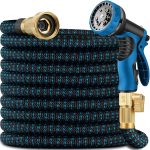
Best 100 ft Expandable Expanding Garden Hose Review garden hose – Oemiu
100 ft Expandable Garden Hose Review: Is It Right for Your Yard?
The quest for the perfect garden hose is a journey many homeowners undertake, year after year. Traditional rubber hoses, while durable, can be heavy, unwieldy, and a pain to store. This has led to a surge in popularity for expandable garden hoses, promising a lightweight, compact, and kink-free watering experience. Among these, the 100 ft expandable garden hose stands out as a versatile option for a range of yard sizes. But does it live up to the hype? This comprehensive review will delve into the specifics of this type of hose, exploring its pros, cons, what to look for when buying, and how it compares to other garden hose options.
The Allure of Expandable Garden Hoses: Convenience Redefined
Expandable garden hoses, sometimes referred to as pocket hoses or flexible garden hoses, have captured the attention of gardeners for a compelling reason: convenience. The core concept is simple yet ingenious. When not in use, the hose shrinks down to a fraction of its extended length, often around one-third. Once water pressure is applied, it magically expands, reaching its advertised length, in this case, 100 feet. This inherent design offers several advantages over traditional hoses, primarily related to weight, storage, and ease of use. Imagine lugging a heavy rubber hose across your yard versus carrying a lightweight, compact expandable hose – the difference is immediately apparent.
Storage is another significant benefit. Traditional hoses can take up considerable space, often requiring bulky hose reels or cumbersome coiling. Expandable hoses, on the other hand, can be easily stored in a small bucket, shelf, or even hung on a hook. This is particularly appealing for those with limited storage space, such as apartment dwellers or homeowners with smaller yards. Furthermore, the flexible nature of expandable hoses helps to prevent kinks and tangles, a common frustration with their rubber counterparts. Anyone who has spent countless minutes untangling a stubbornly knotted hose will appreciate this feature. The promise of a hassle-free watering experience is a powerful draw for both seasoned gardeners and beginners alike. However, it’s crucial to understand that not all expandable hoses are created equal, and their performance can vary greatly depending on factors like material quality and construction.
Consider, for example, someone with a large garden who uses a traditional 50-foot rubber hose. They frequently have to drag the heavy hose around, struggling with kinks and constantly repositioning it to reach all areas of their garden. Switching to a 100 ft expandable garden hose would significantly reduce the physical strain and improve their overall gardening experience. They could easily reach all corners of their garden without the constant need to move the hose. This ease of use can translate to more time spent enjoying gardening and less time struggling with equipment.
Key Features to Consider Before Buying a 100 ft Expandable Garden Hose
Before rushing out to purchase the first 100 ft expandable garden hose you see, it’s essential to understand the key features that differentiate high-quality hoses from those prone to early failure. The materials used in construction, the type of connector fittings, and the overall design all play a crucial role in the hose’s durability, performance, and longevity. Investing a little time in researching these features can save you money and frustration in the long run.
Inner Tube Material: The inner tube is the heart of an expandable hose, responsible for containing the water pressure and allowing the hose to expand. The most common materials used are latex, double-layer latex, and triple-layer latex. Latex offers good flexibility and expansion capabilities, but it can be susceptible to punctures and degradation from UV exposure. Double-layer and triple-layer latex tubes provide increased durability and resistance to leaks, making them a worthwhile upgrade. Some hoses utilize a thermoplastic elastomer (TPE) inner tube, which is known for its high elasticity and resistance to chemicals and temperature extremes. TPE is generally considered a more durable and long-lasting option than latex, but it may also come with a higher price tag.
Outer Fabric: The outer fabric serves as a protective layer for the inner tube, shielding it from abrasion, punctures, and UV damage. Woven polyester is the most common material used for the outer fabric, offering a good balance of strength and flexibility. Look for hoses with a tightly woven fabric, as this provides better protection against snags and tears. Some hoses feature a thicker, more durable fabric, such as nylon or a reinforced polyester blend, which can further enhance their lifespan. The quality of the stitching on the outer fabric is also important, as weak or poorly executed stitching can lead to premature wear and tear.
Connector Fittings: The connector fittings are responsible for connecting the hose to your faucet and nozzle or sprinkler. Brass fittings are generally considered the most durable and reliable option, as they are resistant to corrosion and can withstand high water pressure. Aluminum fittings are a lighter and more affordable alternative, but they are more prone to corrosion and damage. Plastic fittings are the least durable option and should be avoided if possible, especially in areas with high water pressure. Ensure the fittings are securely attached to the hose and that the threads are clean and well-defined to prevent leaks. The size of the fitting also matters; standard ¾-inch fittings are compatible with most faucets and accessories.
Hose Diameter: While the extended length is the most prominently advertised feature, the inner diameter of the hose affects water flow. Most expandable hoses have a standard inner diameter of ½ inch or 3/8 inch. While sufficient for most watering tasks, a smaller diameter can reduce water pressure, especially over longer distances. If you need high water pressure for tasks like power washing or filling large containers, consider looking for an expandable hose with a larger inner diameter, if available.
Burst Pressure: The burst pressure indicates the maximum water pressure the hose can withstand before bursting. A higher burst pressure generally indicates a more durable and reliable hose. Look for hoses with a burst pressure of at least 150 PSI (pounds per square inch), and preferably higher if you have high water pressure at your home.
100 ft Expandable Garden Hose: Pros and Cons
Like any product, the 100 ft expandable garden hose comes with its own set of advantages and disadvantages. Understanding these pros and cons can help you make an informed decision about whether it’s the right choice for your needs. While the convenience factor is undeniable, it’s important to consider the potential drawbacks and limitations.
Pros:
- Lightweight and Easy to Maneuver: Significantly lighter than traditional rubber hoses, making it easier to carry and move around the yard.
- Compact Storage: Shrinks down to a fraction of its extended length for easy storage in small spaces.
- Kink-Free Design: The flexible nature of the hose helps to prevent kinks and tangles, saving you time and frustration.
- Long Reach: The 100-foot length provides ample reach for most residential yards.
- Relatively Inexpensive: Generally more affordable than high-quality rubber hoses of comparable length.
Cons:
- Durability Concerns: Expandable hoses are generally less durable than traditional rubber hoses and may be more prone to leaks and punctures.
- Water Pressure Reduction: The smaller inner diameter can reduce water pressure, especially over longer distances.
- Lifespan: Expandable hoses typically have a shorter lifespan than rubber hoses, especially with frequent use and exposure to the elements.
- Requires Water Pressure: The hose relies on water pressure to expand fully; low water pressure may result in reduced length and performance.
- Potential for Bursting: If the hose is exposed to excessive water pressure or sharp objects, it can burst.
Consider someone who primarily uses their garden hose for light watering tasks, such as watering flowerbeds and potted plants. For them, the lightweight and easy-to-store nature of the 100 ft expandable garden hose would be a significant advantage, outweighing the potential durability concerns. However, someone who needs to use a garden hose for power washing or other high-pressure applications might find that the expandable hose doesn’t provide sufficient water pressure.
Another important factor to consider is climate. In regions with extreme temperatures, both hot and cold, the materials used in expandable hoses can degrade more quickly. Direct sunlight and freezing temperatures can shorten the hose’s lifespan, making it essential to store it properly when not in use.
Comparing 100 ft Expandable Garden Hoses to Traditional Rubber Hoses
The choice between a 100 ft expandable garden hose and a traditional rubber hose often boils down to a trade-off between convenience and durability. Rubber hoses have been the industry standard for decades, known for their robustness and longevity. However, their weight and bulkiness can be a deterrent for some users. Expandable hoses offer a compelling alternative, but they come with their own set of limitations. A side-by-side comparison can help illustrate the key differences and guide your decision.
| Feature | 100 ft Expandable Garden Hose | Traditional Rubber Hose |
|---|---|---|
| Weight | Lightweight (typically 3-5 lbs) | Heavy (typically 10-15 lbs) |
| Storage | Compact; easily stored in a small space | Bulky; requires significant storage space |
| Durability | Less durable; prone to leaks and punctures | Highly durable; resistant to damage |
| Kink Resistance | Generally kink-resistant | Prone to kinks and tangles |
| Water Pressure | May reduce water pressure, especially over long distances | Maintains consistent water pressure |
| Lifespan | Shorter lifespan (typically 1-3 years) | Longer lifespan (typically 5-10 years or more) |
| Price | Generally less expensive | Generally more expensive |
As the table illustrates, the 100 ft expandable garden hose excels in areas of weight, storage, and kink resistance, making it a convenient option for many users. However, it falls short in terms of durability and longevity compared to traditional rubber hoses. Rubber hoses, while heavier and more cumbersome, offer superior resistance to damage and a longer lifespan, making them a more reliable choice for demanding tasks and frequent use.
Consider the frequency of use. If you only need a garden hose occasionally for light watering tasks, the convenience of an expandable hose might outweigh the durability concerns. However, if you plan to use your hose daily for heavy-duty tasks like pressure washing or construction, a rubber hose would be a more prudent investment. Moreover, if you need a very long garden hose, like a super long garden hose that extends hundreds of feet, the expandable ones might not be the best bet.
Tips for Maximizing the Lifespan of Your 100 ft Expandable Garden Hose
While expandable hoses may not be as inherently durable as rubber hoses, there are several steps you can take to maximize their lifespan and prevent premature failure. Proper care and maintenance can significantly extend the life of your 100 ft expandable garden hose, ensuring you get the most value for your money.
- Avoid Dragging on Rough Surfaces: Dragging the hose across concrete, gravel, or other abrasive surfaces can damage the outer fabric and inner tube, leading to leaks and punctures. Lift and carry the hose whenever possible, especially when moving it across rough terrain. Consider using a hose reel or hanger to protect the hose from direct contact with the ground.
- Drain the Hose After Each Use: Leaving water inside the hose can put unnecessary stress on the inner tube and connector fittings, especially in extreme temperatures. After each use, drain the hose completely by disconnecting it from the faucet and nozzle and allowing the water to flow out. You can also gently coil the hose to help remove any remaining water.
- Store in a Shaded Area: Direct sunlight can degrade the latex inner tube and outer fabric, shortening the hose’s lifespan. Store the hose in a shaded area, such as a garage, shed, or covered patio, when not in use. If you must store it outdoors, consider covering it with a tarp or protective cover.
- Avoid Extreme Temperatures: Extreme heat and cold can damage the hose’s materials. Avoid leaving the hose exposed to direct sunlight in hot weather or allowing it to freeze in cold weather. If you live in an area with extreme temperatures, consider storing the hose indoors during the off-season.
- Regulate Water Pressure: Excessive water pressure can put undue stress on the hose and cause it to burst. Use a pressure regulator to ensure the water pressure does not exceed the hose’s maximum burst pressure. Check your home’s water pressure with a pressure gauge to ensure it is within a safe range.
- Inspect Regularly: Regularly inspect the hose for signs of wear and tear, such as leaks, cracks, or abrasions. Address any issues promptly to prevent further damage. Repair minor leaks with a hose repair kit or replace the hose if necessary.
- Use a Hose Nozzle with Care: Avoid using hose nozzles with sharp edges or excessive force, as this can damage the hose’s inner tube. Choose a nozzle with a smooth, rounded design and adjust the water pressure gradually.
By following these simple tips, you can significantly extend the lifespan of your 100 ft expandable garden hose and enjoy its convenience for years to come. Remember that proper care and maintenance are essential for any garden hose, regardless of its type or construction. Even the best flexible and expandable garden hose will fail prematurely if it is not treated with care.
The Future of Garden Hoses: Innovations and Advancements
The garden hose industry is constantly evolving, with manufacturers continuously seeking to improve the durability, performance, and convenience of their products. While traditional rubber hoses and expandable hoses remain the dominant options, several innovations and advancements are emerging that promise to reshape the future of garden hoses. These advancements focus on materials, design, and functionality, aiming to address the limitations of existing hoses and provide users with a superior watering experience.
One area of innovation is in the development of more durable and weather-resistant materials. Researchers are exploring new polymers and composite materials that can withstand extreme temperatures, UV exposure, and abrasion without compromising flexibility. These materials aim to provide the best of both worlds – the durability of rubber hoses with the lightweight and compact nature of expandable hoses. For instance, some manufacturers are experimenting with advanced thermoplastic elastomers (TPEs) that offer superior elasticity and resistance to chemicals and weathering compared to traditional latex.
Another area of focus is on improving the design of expandable hoses to enhance their durability and performance. This includes using multi-layer construction techniques to reinforce the inner tube and outer fabric, as well as incorporating innovative connector designs to prevent leaks and ensure a secure connection. Some manufacturers are also exploring the use of braided stainless steel outer layers to provide exceptional abrasion resistance and prevent punctures.
Beyond materials and design, there are also advancements in hose functionality. Smart garden hoses are emerging, incorporating sensors and connectivity features to monitor water usage, detect leaks, and automate watering schedules. These smart hoses can be controlled via smartphone apps, allowing users to remotely manage their watering systems and conserve water. Other innovations include self-retracting hoses that automatically coil themselves for easy storage and hoses with built-in spray nozzles that offer multiple spray patterns at the touch of a button.
As technology continues to advance, we can expect to see even more innovative garden hose solutions emerge in the coming years. These advancements will likely focus on creating hoses that are more durable, user-friendly, and environmentally friendly, ultimately making gardening and outdoor maintenance tasks easier and more enjoyable. The days of struggling with heavy, kink-prone hoses may soon be a thing of the past, thanks to these ongoing innovations.
Frequently Asked Questions (FAQ)
What is the typical lifespan of a 100 ft expandable garden hose?
The lifespan of a 100 ft expandable garden hose can vary considerably depending on several factors, including the quality of materials used, the frequency of use, and the care and maintenance it receives. Generally, you can expect an expandable garden hose to last anywhere from 1 to 3 years. However, with proper care and storage, some hoses may last longer. Factors that can shorten the lifespan include exposure to direct sunlight, extreme temperatures, dragging the hose across rough surfaces, and exceeding the hose’s maximum water pressure. Investing in a higher-quality hose with durable materials and following the manufacturer’s recommendations for care and maintenance can help extend its lifespan. Regularly inspecting the hose for leaks or damage and addressing any issues promptly can also prevent further deterioration. Remember that while expandable hoses offer convenience, they typically don’t last as long as traditional rubber hoses.
How do I prevent my expandable garden hose from bursting?
Preventing your expandable garden hose from bursting involves a few key strategies focused on managing water pressure, protecting the hose from damage, and storing it properly. First, always ensure that your home’s water pressure is within the hose’s recommended burst pressure. You can use a pressure regulator to control the water pressure and prevent it from exceeding the hose’s limits. Second, avoid dragging the hose across rough or abrasive surfaces, as this can weaken the outer fabric and inner tube, making it more susceptible to bursting. Instead, lift and carry the hose when moving it around your yard. Third, drain the hose completely after each use to relieve pressure on the inner tube and prevent damage from freezing temperatures. Fourth, store the hose in a shaded area away from direct sunlight and extreme temperatures, as these can degrade the hose’s materials over time. Regularly inspect the hose for any signs of wear or damage, such as leaks, cracks, or bulges, and address any issues promptly to prevent them from escalating into a burst. By following these precautions, you can significantly reduce the risk of your expandable garden hose bursting.
Can I use an expandable garden hose with a pressure washer?
While it might be tempting to use your expandable garden hose with a pressure washer, it’s generally not recommended, and here’s why. Expandable hoses are designed for typical watering tasks and often have a smaller inner diameter than traditional hoses, which can restrict water flow and reduce the pressure washer’s performance. More importantly, expandable hoses typically have a lower burst pressure than what’s required for most pressure washers. Connecting an expandable hose to a pressure washer could cause the hose to burst, potentially damaging the pressure washer and causing injury. Pressure washers require a consistent and high-volume water supply, which an expandable hose may not be able to provide. It’s always best to use a traditional rubber hose specifically designed for pressure washers, as these hoses are built to withstand high pressure and deliver the necessary water flow for optimal performance. Check your pressure washer’s manual for specific hose requirements and recommendations.
Is it safe to drink water from an expandable garden hose?
The safety of drinking water from an expandable garden hose is a concern that many people have, and the answer is generally no, it’s not recommended. While the water may appear clean, the materials used in the construction of expandable hoses, particularly the inner tube, may contain chemicals that can leach into the water over time. These chemicals, such as phthalates and lead, can be harmful to your health if ingested. Additionally, expandable hoses can harbor bacteria and other microorganisms, especially if they are not properly drained and stored. Drinking water from an expandable hose, especially one that has been sitting in the sun, can expose you to these contaminants. For drinking water, it’s always best to use a potable water hose specifically designed for that purpose. These hoses are made from food-grade materials that are safe for drinking water and won’t leach harmful chemicals. If you need to fill a drinking water container, always use a potable water hose to ensure the water is safe for consumption.
How do I store my expandable garden hose for the winter?
Proper storage of your expandable garden hose during the winter months is crucial for preventing damage and extending its lifespan. Before storing, thoroughly drain the hose of all water. Connectors should be disconnected from both the water source and the spray nozzle. Lay the hose flat and allow all water to drain. Gently shake or coil the hose to dislodge any remaining water droplets. Once the hose is completely dry, store it in a cool, dry place away from direct sunlight and freezing temperatures. A garage, shed, or basement are ideal storage locations. Avoid storing the hose outdoors, as exposure to freezing temperatures can cause the inner tube to crack and become brittle. You can loosely coil the hose or hang it on a hose hanger to prevent kinks and tangles. Storing your expandable garden hose properly during the winter will help protect it from damage and ensure it’s ready to use when spring arrives.
What is the best way to clean an expandable garden hose?
Cleaning an expandable garden hose is a simple process that can help prevent the buildup of mold, mildew, and bacteria. Start by disconnecting the hose from the faucet and nozzle. Rinse the exterior of the hose with clean water to remove any dirt or debris. For stubborn stains or buildup, you can use a mild soap solution. Mix a small amount of dish soap with water and apply it to the hose with a soft brush or sponge. Gently scrub the hose to remove any grime. Avoid using harsh chemicals or abrasive cleaners, as these can damage the hose’s materials. Once you’ve cleaned the exterior of the hose, flush the interior with clean water to remove any soap residue. Allow the hose to dry completely before storing it. Regularly cleaning your expandable garden hose will help keep it free from contaminants and extend its lifespan. Consider cleaning the hose every few months or as needed to maintain its cleanliness.
Are all expandable garden hoses the same quality?
No, not all expandable garden hoses are created equal; there is a significant range in quality and durability. Key factors affecting quality include the material of the inner tube (latex, double latex, triple latex, TPE), the outer fabric (woven polyester, nylon, reinforced blends), and the connector fittings (brass, aluminum, plastic). Higher-quality hoses typically use multi-layer latex or TPE inner tubes, durable outer fabrics, and brass fittings, providing better resistance to leaks, punctures, and bursts. Lower-quality hoses may use thinner, less durable materials and plastic fittings, which are more prone to failure. The construction and stitching of the hose also play a role in its overall quality. Tightly woven fabrics and secure stitching offer better protection against wear and tear. Reading customer reviews and comparing specifications can help you differentiate between high-quality and low-quality expandable garden hoses. Investing in a higher-quality hose may cost more upfront, but it can save you money in the long run by reducing the need for frequent replacements.

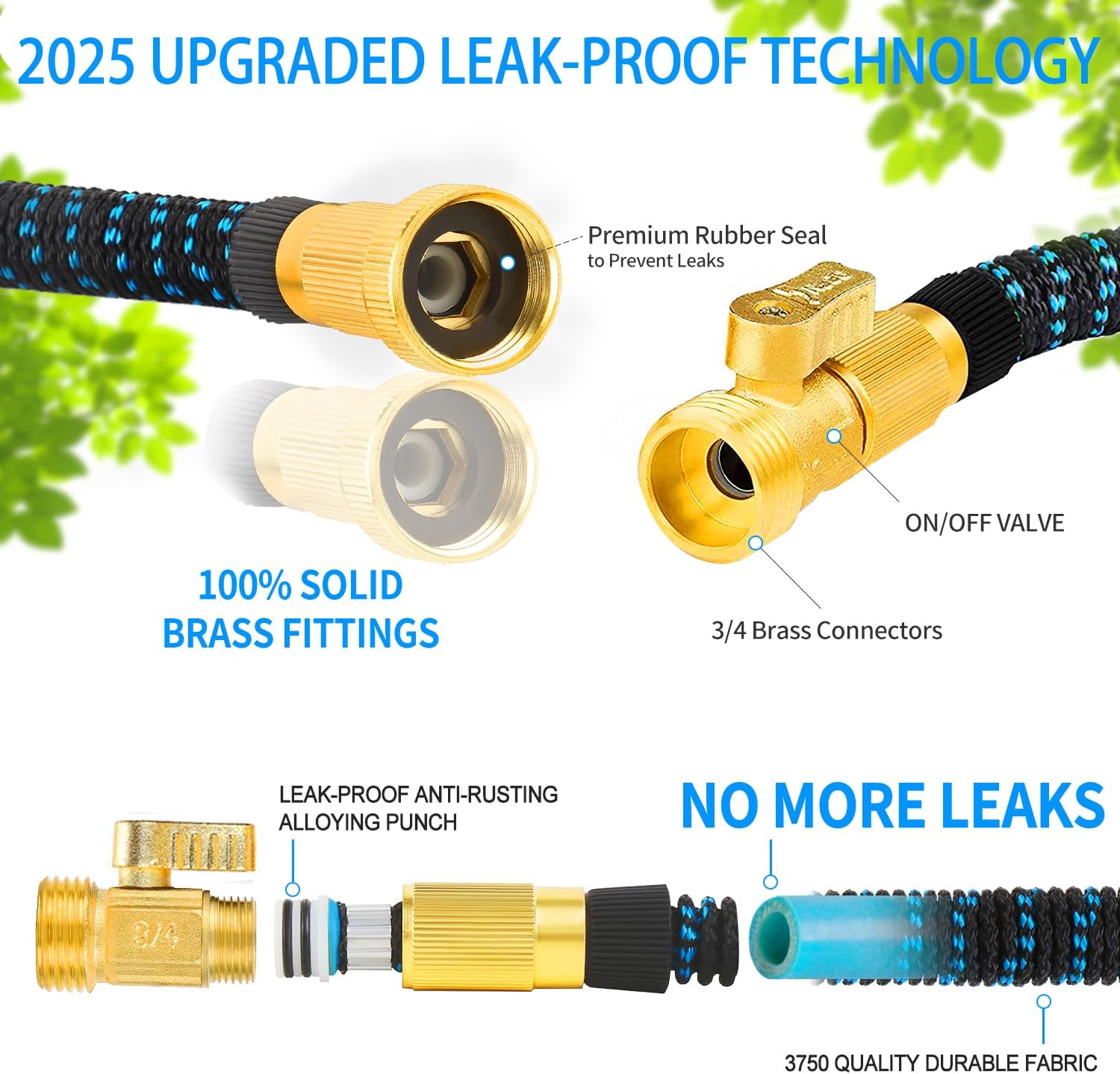
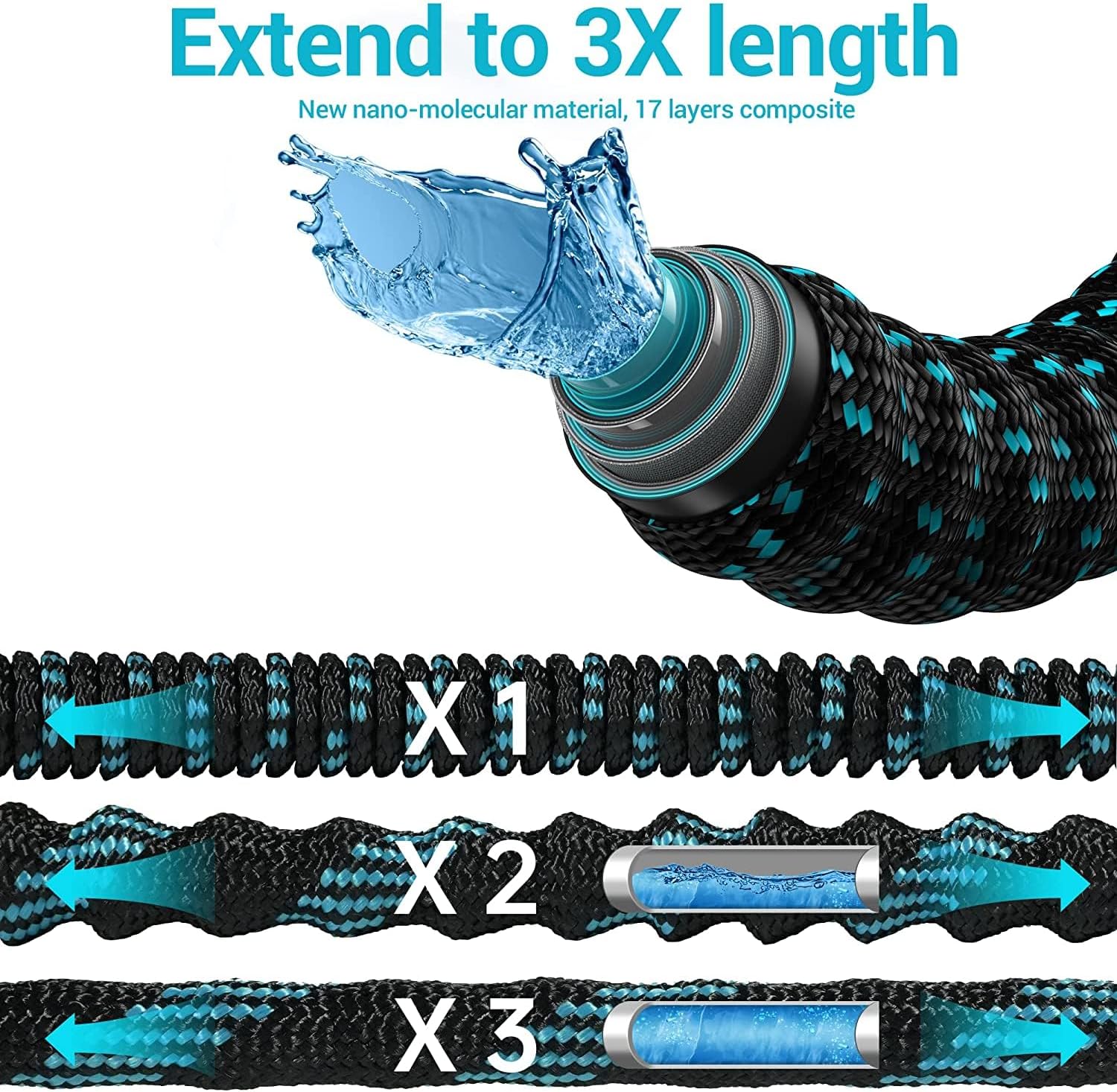
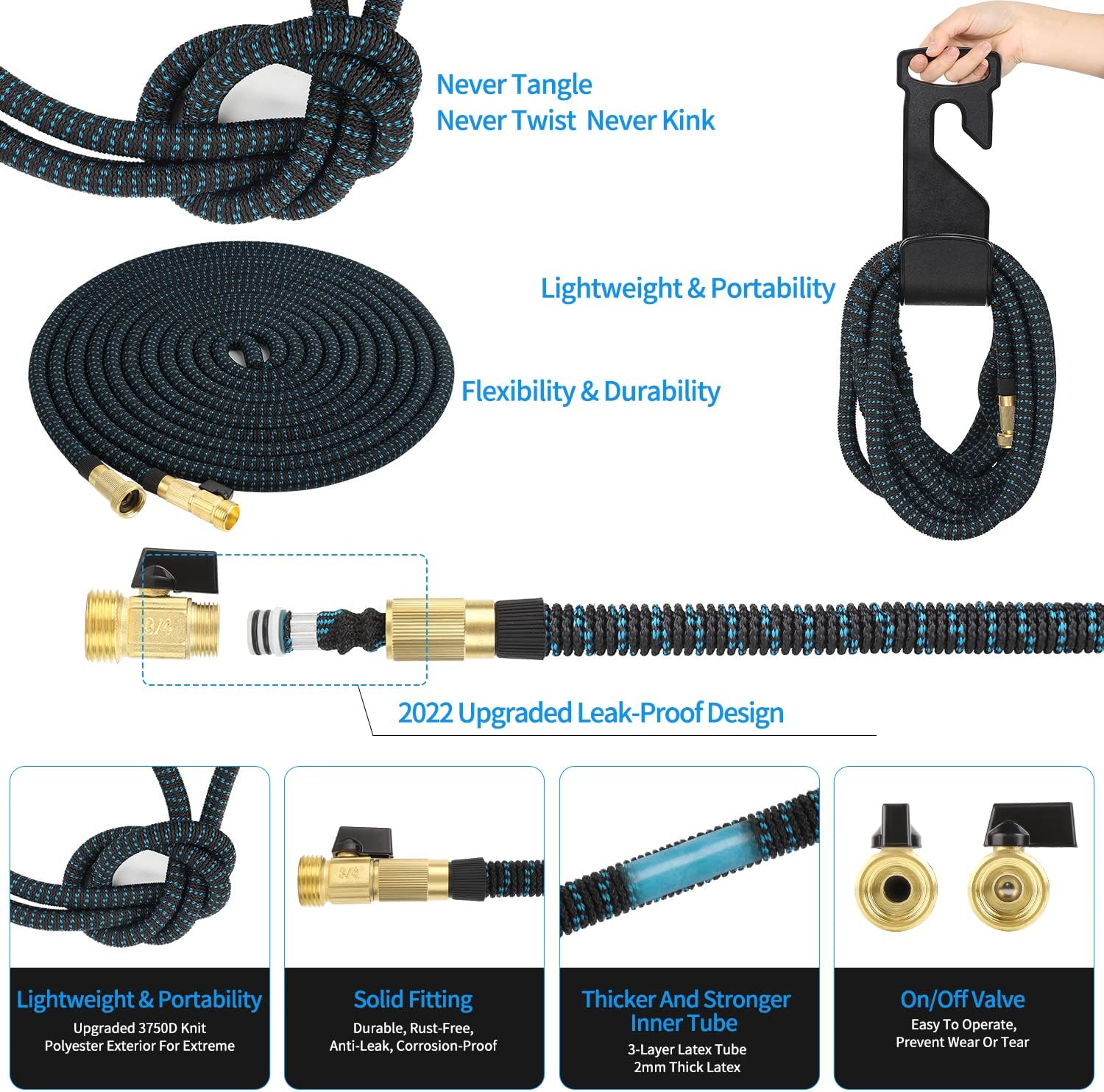
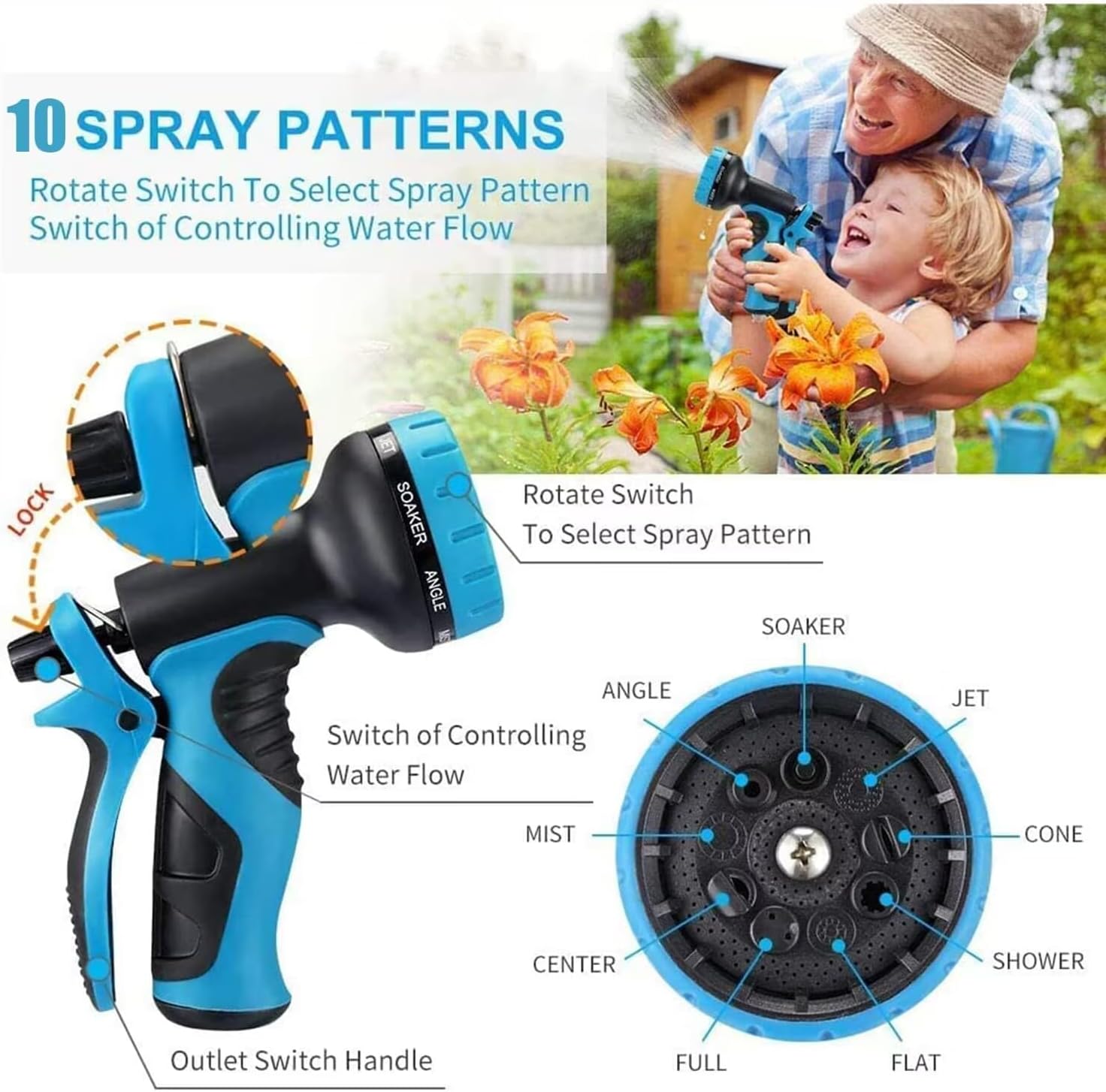
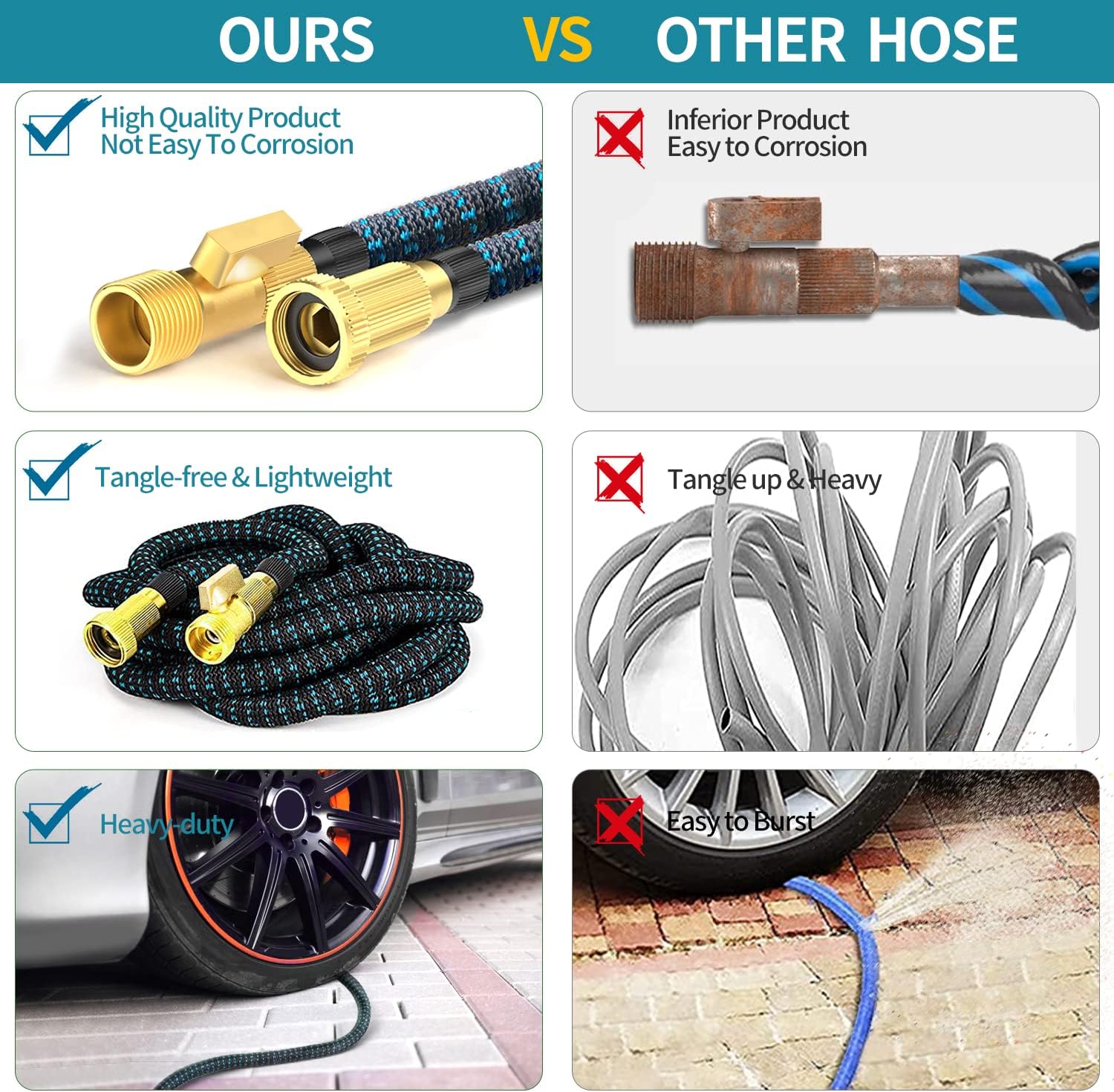
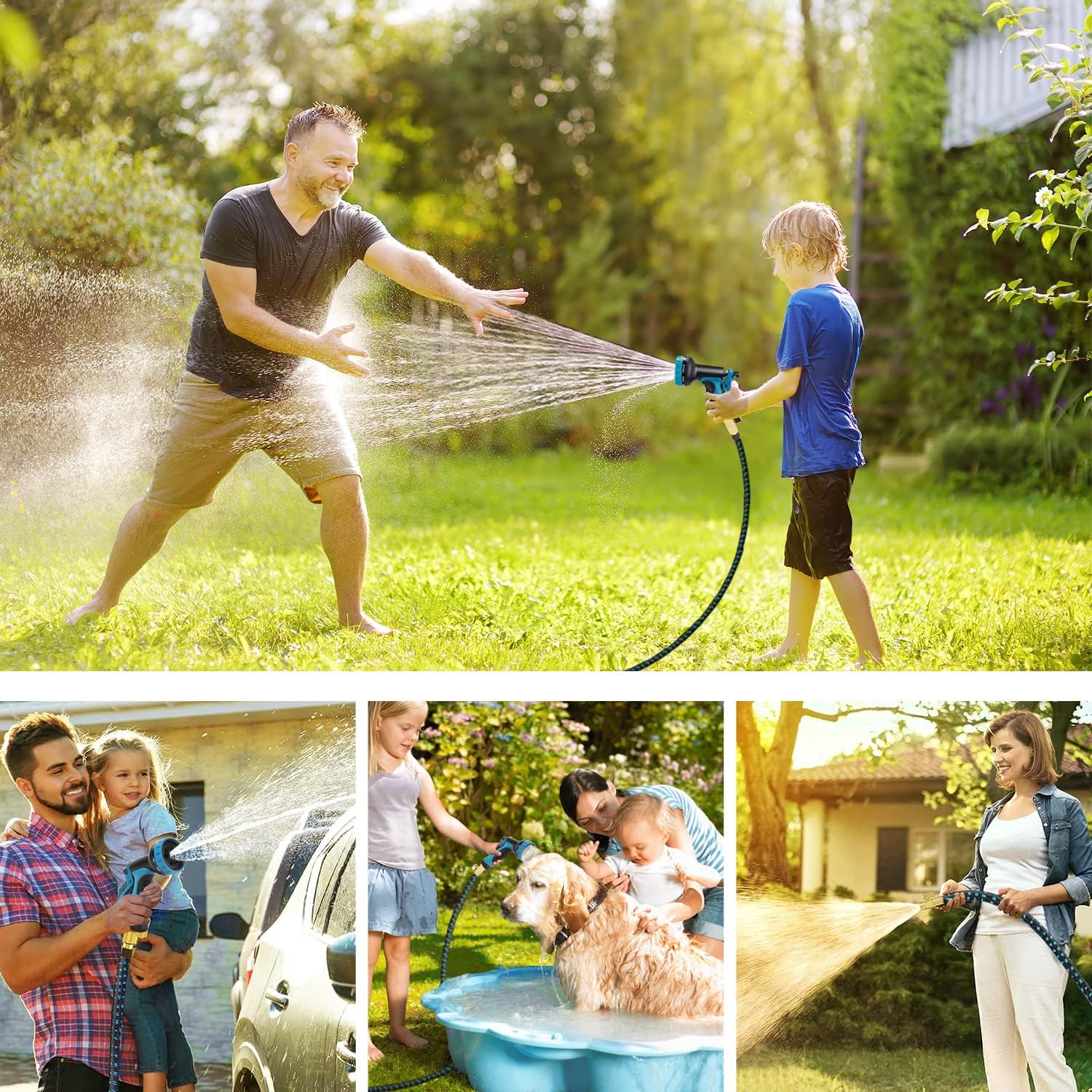
Price: $64.99 - $47.49
(as of Sep 08, 2025 12:19:53 UTC – Details)




